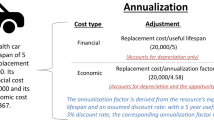Abstract
When choosing from a menu of treatment alternatives, the optimal treatment depends on the objective function and the assumptions of the model. The classical decision rule of cost-effectiveness analysis may be formulated via two different objective functions: (i) maximising health outcomes subject to the budget constraint or (ii) maximising the net benefit of the intervention with the budget being determined ex post. We suggest a more general objective function of (iii) maximising return on investment from available resources with consideration of health and non-health investments. The return on investment approach allows to adjust the analysis for the benefits forgone by alternative non-health investments from a societal or subsocietal perspective. We show that in the presence of positive returns on non-health investments the decision-maker’s willingness to pay per unit of effect for a treatment program needs to be higher than its incremental cost-effectiveness ratio to be considered cost-effective.
Similar content being viewed by others
References
Al M.J., Feenstra T., Brouwer W.B. (2004). Decision makers’ views on health care objectives and budget constraints: Results from a pilot study. Health Policy 70, 33–48
Birch S., Gafni A. (1992). Cost effectiveness/utility analyses. Do current decision rules lead us to where we want to be?. Journal of Health Economics 11, 279–296
Birch S., Gafni A. (1993). Changing the problem to fit the solution: Johannesson and Weinstein’s (mis) application of economics to real world problems. Journal of Health Economics 12, 469–476
Briggs A.H., Goeree R., Blackhouse G., O’Brien B.J. (2002). Probabilistic analysis of cost-effectiveness models: Choosing between treatment strategies for gastroesophageal reflux disease. Medical Decision Making, 22, 290–308
Briggs A.H., Gray A.M. (1999). Handling uncertainty when performing economic evaluation of healthcare interventions. Health Technology Assessment 3, 1–134
Devlin N., Parkin D. (2004). Does NICE have a cost-effectiveness threshold and what other factors influence its decisions?. A binary choice analysis. Health Economics 13, 437–452
Karlsson G., Johannesson M. (1996). The decision rules of cost-effectiveness analysis. Pharmacoeconomics 9, 113–120
Sendi P. (2002). Some reflections on cost-effectiveness analysis and budget allocation in medicine. Expert Review of Pharmacoeconomics and Outcomes Research 2, 191–193
Sendi, P. (2005). Decision rules and uncertainty in the economic evaluation of health care technologies. PhD Disseration, Erasmus University Rottredam.
Sendi P., Al M.J. (2003). Revisiting the decision rule of cost-effectiveness analysis under certainty and uncertainty. Social Science and Medicine 57, 969–974
Sendi P., Al M.J., Rutten F.F.H. (2004a). Portfolio theory and cost-effectiveness analysis: A further discussion. Value Health 7, 595–601
Sendi P., Al M.J., Zimmermann H. (2004b). A risk-adjusted approach to comparing the return on investment in health care programs. International Journal of Health Care Finance and Economics 4, 199–210
Sendi P.P., Palmer A.J., Marinello C.P. (1997). Health state utilities in dentistry. A review. Acta Med Dent Helvetica 2, 243–248
Stinnett A.A., Mullahy J. (1998). Net health benefits: A new framework for the analysis of uncertainty in cost-effectiveness analysis. Medical Decision Making, 18, S68–S80
Stinnett A.A., Paltiel A.D. (1996). Mathematical programming for the efficient allocation of health care resources. Journal of Health Economics 15, 641–653
Tambour M., Zethraeus N., Johannesson M. (1998). A note on confidence intervals in cost-effectiveness analysis. International Journal of Technology Assessment in Health Care 14, 467–471
Weinstein M.C. (1995). From cost-effectiveness ratios to resource allocation: Where to draw the line?. In: Sloan F.A. (ed). Valuing health care. Cambridge UK, Cambridge University Press
Weinstein M.C., Zeckhauser R.J. (1973). Critical ratios and efficient allocation. Journal of Public Economics 2, 147–157
Zitzamnn N.U., Marinello C.P., Sendi P. (2006). A cost-effectiveness analysis of implant overdentures. Journal of Dental Research 85, 717–721
Author information
Authors and Affiliations
Corresponding author
Rights and permissions
About this article
Cite this article
Sendi, P. Bridging the gap between health and non-health investments: moving from cost-effectiveness analysis to a return on investment approach across sectors of economy. Int J Health Care Finance Econ 8, 113–121 (2008). https://doi.org/10.1007/s10754-008-9032-4
Received:
Accepted:
Published:
Issue Date:
DOI: https://doi.org/10.1007/s10754-008-9032-4



